 Mexico Paper Money Collection
Mexico Paper Money Collection Mexico Paper Money Collection
Mexico Paper Money Collection
| [ Last Update: Tuesday, 03-Nov-2009 20:02:24 EST ] |
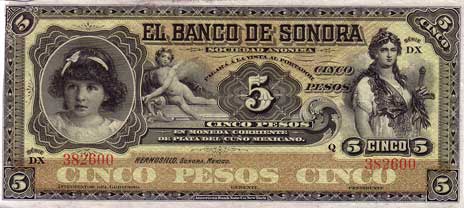 | El Banco De Sonora 5 Pesos Note, 1897-1911 Issue, Series DX These notes were hand signed and dated as they were issued by the bank. Size: 181 x 81 mm Printer: American Bank Note Company |
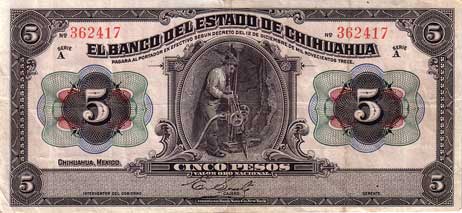 | Pick# S132a - El Banco Del Estado De Chihuahua 5 Pesos Note, 1913 Issue, Series A Obverse: Miner with drill at center Reverse: Eagle with snake, the national symbol of Mexico Printer: American Bank Note Company Size: 180 x 83 mm El Banco Del Estado De Chihuahua was established by decree on December 12, 1913. Governor Villa envisioned this bank as a support to land reform in Chihuahua. It would offer loans to farmers, ranchers, and small businessmen at reasonable rates of interest. In January 1914, Villa wrote to Carranza asking for $5,000,000 pesos to underwrite the establishment of the bank. There is no evidence that Carranza deigned to reply to Villa's request. As the revolution continued, Villa put off the opening the bank. He had to accumulate the funds to underwrite it, and he wanted to delay land reform until the soldiers of the Division of the North could return to their homes and participate. The Banco del Estado de Chihuahua finally opened in mid-September 1915, but functioned only as a holding company for confiscated lands and assets of the aristocracy. The bank notes, prepared by the American Bank Note Company of New York, were never issued. The total value of the notes was probably 10,000,000 pesos. A small quantity "escaped" to circulation in 1915, being used by local militia leaders to pay their troops. All notes are dated 12 December 1913. |
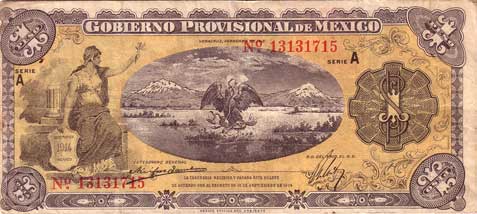 | Gobierno Provisional de Mexico 1 Pesos Note, 1914 Issue, Veracruz, Series A (P S1101a) Size: 186 x 81 mm |
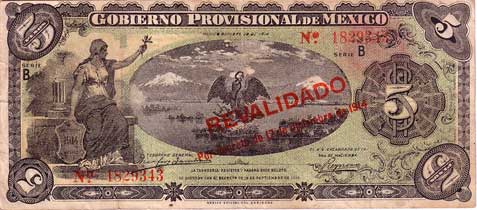 | Gobierno Provisional de Mexico 5 Pesos Note, 1914 Issue, Mexico City, Series B Revalidated overprint (P S702b) Size: 186 x 81 mm |
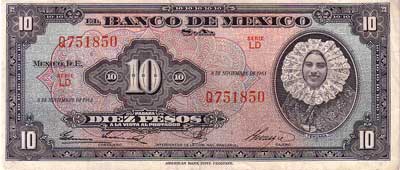 | Pick# 58i -Banco De Mexico 10 Pesos Note, 1954 Issue, 08 November 1961, Series LD Obverse: Portrait of E. Ruiz de Velazquez at right Reverse: Road to Guanajuato at center Size: 156 x 67 mm Printer: American Bank Note Company |
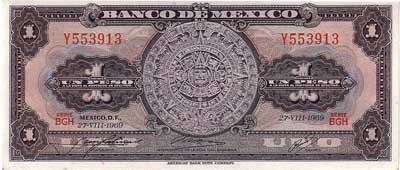 | Pick# 59k -Banco De Mexico 1 Pesos Note, 27 August 1969, 1957-1961 Issue, Series BCY-BGJ Obverse: Piedra del Sol (Aztec calendar sun stone) Reverse: Indepence monument at center Size: 156 x 66 mm Printer: American Bank Note Company |
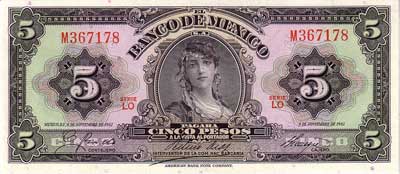 | Pick# 60g -Banco De Mexico 5 Pesos Note, 11 November 1961, 1957-1961 Issue, Series LO Obverse: Gypsy woman at center Reverse: Independence monument at center Size: 156 x 68 mm Printer: American Bank Note Company |
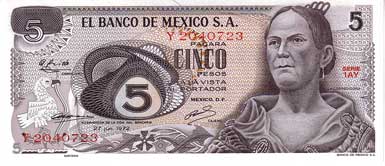 | Pick# 62c -Banco De Mexico 5 Pesos Note, 27 June 1972, 1969-1974 Issue, Series 1AY Obverse: Josefa Ortiz de Domingeuz at right Reverse: Yucca plant, Arcos de Queretaro, Queretaro city view, and national arms Size: 150 x 66 mm |
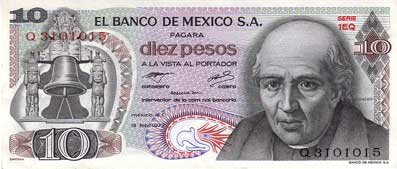 | Pick# 63i - Banco De Mexico 10 Pesos Note, 18 February 1977, 1969-1974 Issue, Series 1EQ Obverse: Bell at left, M. Hidalgo y Castila at right Reverse: Dolores Cathedral Size: 155 x 66 mm |
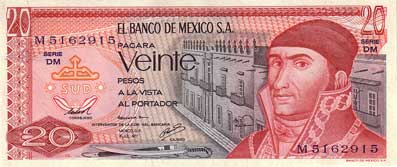 | Pick# 64d - Banco De Mexico 20 Pesos Note, 08 July 1977, i1969-1974 Issue, Series DM Obverse: José María Teclo Morelos y Pavón at right with building in background Reverse: Pyramid of Quetzalcoatl at Teotihuacan Size: 155 x 66 mm José María Teclo Morelos y Pavón (September 30, 1765, Valladolid, now Morelia, Michoacán - December 22, 1815, San Cristóbal Ecatepec, State of México) was a Mexican Roman Catholic priest and revolutionary rebel leader who led the Mexican War of Independence movement, assuming its leadership after the execution of Miguel Hidalgo y Costilla in 1811. He was later captured by the Spanish colonial authorities and executed for treason in 1815. |
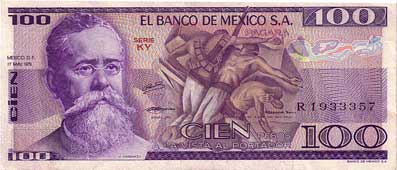 | Pick# 68b - El Banco De Mexico S.A. 20 Pesos Note, 17 May 1979, 1978-1980 Issue, Series KY Obverse: Venustiano Carranza at right, La Trincherai painting by José Clemente Orozcoat at center Reverse: Artifacts from Tula, Hidalgo, Chac Mool statue at Chichen Itza Size: 155 x 66 mm Venustiano Carranza de la Garza (December 29, 1859 - May 21, 1920) was one of the leaders of the Mexican Revolution. He ultimately became President of Mexico following the overthrow of the dictatorial Huerta regime in the summer of 1914 and during his administration the current constitution of Mexico was drafted. He was assassinated near the end of his term of office at the behest of a cabal of army generals resentful at his insistence that his successor be a civilian. The mural La Trincherai is on one of the walls of the San Ildefonso College in the historic center of Mexico City. |
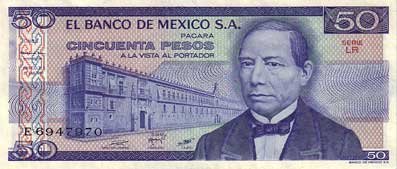 | Pick# 73 - El Banco De Mexico S.A. 50 Pesos Note, 27 January 1981, 1981 Issue, Series LR Obverse: National Palace (Palacio Nacional) in Plaza de la Constitución / El Zócalo in Mexico City at left, Benito Juárez at right Reverse: Urna funeraria Zapoteca (funerary urn) and Zapotec temple in Mitla Size: 155 x 66 mm |
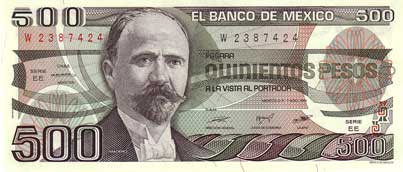 | Pick# 79b - Banco De Mexico 500 Pesos Note, 07 August 1984, 1983-1984 Issue, Series EE Obverse: Franciso Ignacio Madero González at left, narrow serial number style Reverse: Piedra del Sol (Aztec calendar sun stone), Mayan bas-relief Size: 157 x 67 mm Franciso Ignacio Madero González was a politician, writer, and revolutionary who served as President of Mexico from 1911 to 1913 |
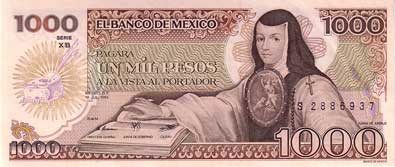 | Pick# 85 - El Banco De Mexico 1000 Pesos Note, 19 July 1985, 1985 Issue, Series XB Obverse: Scholar, poet, nun and writer Juana de Asbaje (Sor Juana Inés de la Cruz de Asbaje y Ramírez de Santillana) touching a book; Quill pen and ink well (see-through register) Reverse: Plaza de Santo Domingo in Mexico City; Quill pen and ink well (a see-through register). Size: 154 x 66 mm Sor Juana Inés de la Cruz (November 12, 1651 or in 1648 - April 17, 1695) was a self-taught Novohispana scholar (mathematician), poet, a writer of the Baroque school and nun. Though she lived in a colonial era when Mexico was part of the Spanish empire, she is considered a Mexican writer, and a precursor to later Mexican literature. |
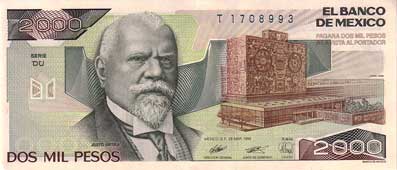 | Pick# 86c - El Banco De Mexico 2000 Pesos Note, 1985 Issue, 28 March 1989, Series DU Obverse: Justo Sierra at left center, Central Library building, National Autonomous University of Mexico, Coyoacán at right, red UV fluorescent fibers, yellow UV fluorescent security strip Reverse: 19th century courtyard Size: 155 x 66 mm Justo Sierra Méndez (Campeche, México, January 26, 1848 - Madrid, Spain, September 13, 1912), was a prominent Mexican writer, journalist, poet and political figure of the second half of the nineteenth century.
|
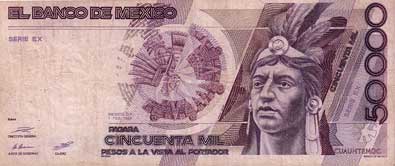 | Pick# 93a - Banco De Mexico 50000 Pesos Note, 01 February 1988, 1985 Issue, Series EX Obverse: Aztec symbols at center, Cuauhtémoc at right Reverse: Aztec and Spaniard fighting at left center Watermark: Cuauhtémoc Size: 154 x 67 mm Cuauhtémoc (also known as Cuauhtemotzin, Guatimozin or Guatemoc; c. 1502– 28 February 1525) was the Aztec ruler (tlatoani) of Tenochtitlan from 1520 to 1521 and long-lasting myth of the Mexican nation.. The name Cuauhtemoc means "One That Has Descended Like an Eagle", commonly rendered in English as "Falling Eagle. |
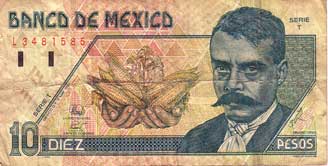 | Pick# 105a - Banco De Mexico 10 Pesos Note, 1994 Issue, 06 May 1994, Series T Obverse: Emiliano Zapata at right, hands holding corn at center Reverse: Machinery at lower left, statue of Zapata on horseback near peasant at center right, building in back Size: 128 x 65 mm Emiliano Zapata Salazar (August 8, 1879 - April 10, 1919) was a leading figure in the Mexican Revolution, which broke out in 1910, and which was initially directed against the president Porfirio Díaz. He formed and commanded an important revolutionary force, the Liberation Army of the South, during the Mexican Revolution. |
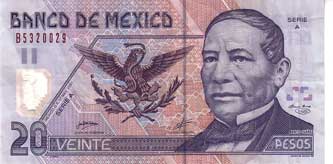 | Pick# 116b - Banco De Mexico 20 Pesos Note, 17 May 2001, 2000-2001 Issue, Series A Obverse: Benito Juárez at right, eagle on a cactus with snake (arms) at center, two electronic sorting bars at left above clear plastic Reverse: Hemicicio a Benito Juárez Momument in Mexico City Size: 130 x 66 mm Benito Pablo Juárez García (March 21, 1806 - July 18, 1872) was a Zapotec Amerindian who served five terms as president of Mexico: 1858-1861 as interim, 1861-1865, 1865-1867, 1867-1871 and 1871-1872. Benito Juárez was the first Mexican leader who did not have a military background, and also the first full-blooded indigenous national to serve as President of Mexico and to lead a country in the Western Hemisphere in over 300 years. For resisting the French occupation, overthrowing the Empire, and restoring the Republic, as well as for his efforts to modernize the country, Juárez is often regarded as Mexico's greatest and most beloved leader. Several towns, schools, parks, streets and monuments have been named to honor and remember him. |
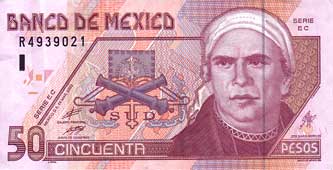 | Pick# 117 - Banco De Mexico 50 Pesos Note, 26 March 2002, 2000-2001 Issue, Series EC Obverse: José Maria Morelos at right, crossed cannons on outlined bow and arrows below his flag at left center, vertical iridescent strip at right, solid black electronic sorting bar at left Reverse: Butterflies at left, boat fishermen at center José María Teclo Morelos y Pavón (September 30, 1765, Valladolid, now Morelia, Michoacán – December 22, 1815, San Cristóbal Ecatepec, State of México) was a Mexican Roman Catholic priest and revolutionary rebel leader who led the Mexican War of Independence movement, assuming its leadership after the execution of Miguel Hidalgo y Costilla in 1811. He was later captured by the Spanish colonial authorities and executed for treason in 1815. |
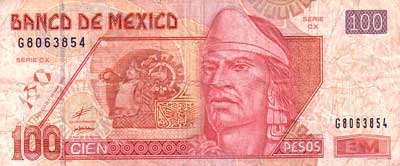 | Pick# 118 - Banco De Mexico 100 Pesos Note, 26 March 2002, 2000-2001 Issue, Series CX Obverse: Nezahualcóyoti at right, Aztec figure at center, vertical iridescent strip at left Xochipilli statue Watermark: Nezahualcóyoti Size: 156 x 65 mm Nezahualcóyotl, meaning "Coyote in fast" or "Coyote who Fasts" (April 28, 1402 – June 4, 1472) was a philosopher, poet and ruler (tlatoani) of the city-state of Texcoco in pre-Columbian Mexico. Unlike other high-profile Mexican figures from the century preceding the Spanish Conquest, Nezahualcoyotl was not a Mexica; his people were the Acolhua, another Nahuan people settled in the eastern part of the Valley of Mexico, settling on the eastern side of Lake Texcoco. Xochipilli was the god of art, games, beauty, dance, flowers, maize, and song in Aztec mythology. His name contains the Nahuatl words xochitl ("flower") and pilli (either "prince" or "child"), and hence means "flower prince". He is also referred to as Macuilxochitl, which means "five flowers." His wife was the human girl Mayahuel, and his twin sister was Xochiquetzal. As one of the gods responsible for fertility and agricultural produce, he was also associated with Tlaloc (god of rain), and Cinteotl (god of maize). |
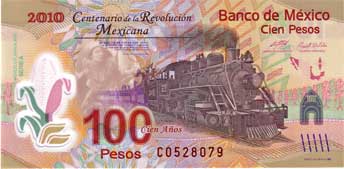 | Banco De Mexico 100 Pesos Note, Commemorative Note for the Bicentennial of the Independence of Mexico, 20 November 2007, Series A Obverse: A locomotive that carried revolutionary troops in 1910, clear plastic cor plant with iridescent husks and leaves Reverse: Soldiers in David Alfaro Siqueiros' mural "Del Porfirismo a la Revolución" Watermark: Woman Size: 134 x 66 mm Porfirio Díaz ruled Mexico as it's dictator for nearly 44 years, from 1877-1911. Despite having given lip service to democracy, in practice he did not believe in it. In the 1910 election in Mexico it is conjectured that in reality he lost the election, but vote rigging and a refusal to acknowledge reality only prompted him to stay in office, in opposition to Franscisco Madero. Shortly after the election a revolt broke out, which initiated the Mexican Revolution, which lasted from 1910-1920 and saw the rise and fall of several characters in Mexican history, including Díaz, Madero etc. In the end forces led by Venustiano Carranza prevailed and the Mexican constitution of 1917 insured more liberal rule, and some degree of political stability. The soliders were called "Adelita" after the classic song from the Revolution called "La Adelita" |
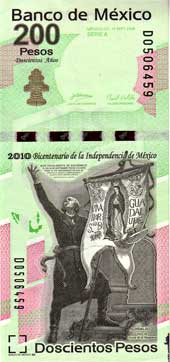 | Banco De Mexico 200 Pesos Note, Commemorative Note for the Bicentennial of the Independence of Mexico, 15 September 2008, Series A Obverse: Miguel Hidalgo with Virgin of Guadalupe banner from a painting by Jesus Enrique Emilio de la Helguera Evans Reverse: Angel of Independence Statue atop Paseo de la Reforma (the Independence Monument) in Mexico City Watermark: Pixel watermark of Angel of Independence torso Size: 141 x 66 mm On 23 September 2009, the Bank of Mexico introduced two new commemorative banknotes. The 200-peso paper note celebrates the bicentenial of independence. It is also noteworthy because it's the first note in the world with a new security feature: the Pixel watermark, developed by ArjoWiggins Security. |